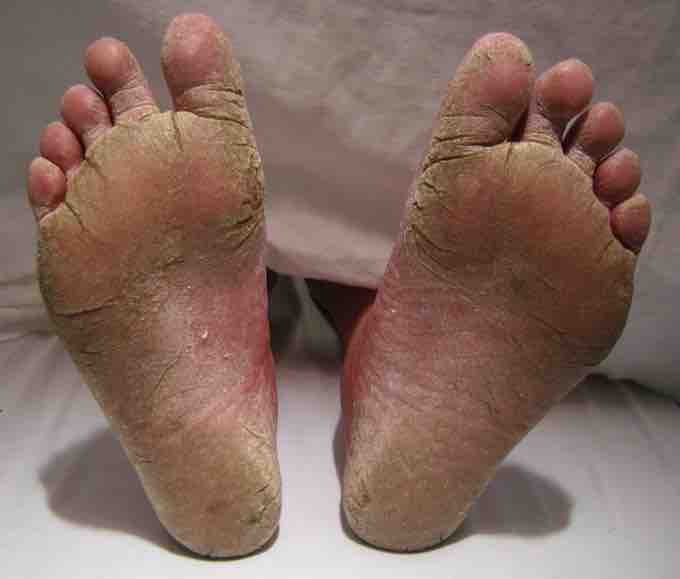A cutaneous condition is any medical condition that affects the integumentary system — the organ system that comprises the entire surface of the body and includes skin, hair, nails, and related muscle and glands. Conditions of the human integumentary system constitute a broad spectrum of diseases, also known as dermatoses, as well as many nonpathologic states (like, in certain circumstances, melanonychia and racquet nails). Common fungal skin and nail diseases include athlete's foot, jock itch, and ringworm.
Athlete's foot (also known as ringworm of the foot and tinea pedis; ) is an infection of the skin that is caused by a fungi in the genus Trichophyton. While it is typically transmitted in moist communal areas where people walk barefoot, the disease requires a warm moist environment, such as the inside of a shoe, in order to incubate. Athlete's foot causes scaling, flaking, and itching of the affected skin. Blisters and cracked skin may also occur, leading to exposed raw tissue, pain, swelling, and inflammation. Secondary bacterial infection can accompany the fungal infection, sometimes requiring a course of oral antibiotics. Athlete's foot can usually be diagnosed by visual inspection of the skin, but where the diagnosis is in doubt direct microscopy of a potassium hydroxide preparation (known as a KOH test) may help rule out other possible causes, such as eczema or psoriasis. Without medication athlete's foot resolves in 30–40% of cases and topical antifungal medication consistently produce much higher percentages of a cure. Conventional treatment typically involves daily or twice daily application of a topical medication in conjunction with hygiene measures outlined in the above section on prevention. Keeping feet dry and practicing good hygiene is crucial to preventing reinfection. Severe or prolonged fungal skin infections may require treatment with oral antifungal medication.

Athlete's Foot
A severe case of athlete's foot.
Tinea cruris, also known as crotch itch, crotch rot, Dhobie itch, eczema marginatum, gym itch, jock itch, jock rot, and ringworm of the groin is a dermatophyte fungal infection of the groin region in any sex, though more often seen in males. As the common name for this condition implies, it causes itching or a burning sensation in the groin area, thigh skin folds, or anus. It may involve the inner thighs and genital areas, as well as extending back to the perineum and perianal areas. Affected areas may appear red, tan, or brown, with flaking, rippling, peeling, or cracking skin. Opportunistic infections (infections that are caused by a diminished immune system) are frequent. Fungus from other parts of the body (commonly tinea pedis or 'athlete's foot') can contribute to this itch. A warm, damp environment allowing the fungus to cultivate greatly contributes; especially with tight, sweaty, or rubbing clothing such as a jockstrap. Medical professionals suggest keeping the groin area clean and dry by drying off thoroughly after bathing and putting on dry clothing right away after swimming or perspiring. Other recommendations to prevent this infection are: not sharing clothing or towels with others, showering immediately after athletic activities, wearing loose cotton underwear, avoiding tight-fitting clothes, and using antifungal powders. Tinea cruris is best treated with topical antifungal medications of the allylamine or azole type.
Dermatophytosis or ringworm is a clinical condition caused by fungal infection of the skin in humans, pets such as cats, and domesticated animals such as sheep and cattle. The term "ringworm" is a misnomer, since the condition is caused by fungi of several different species and not by parasitic worms. The fungi that cause parasitic infection (dermatophytes) feed on keratin, the material found in the outer layer of skin, hair, and nails. These fungi thrive on skin that is warm and moist, but may also survive directly on the outsides of hair shafts or in their interiors. In pets, the fungus responsible for the disease survives in skin and on the outer surface of hairs. Advice often given to prevent this infection includes: avoiding sharing clothing, sports equipment, towels, or sheets and washing clothes in hot water with fungicidal soap after suspected exposure to ringworm. After being exposed to places where the potential of being infected is high, one should wash with an antibacterial and anti-fungal soap or one that contains tea tree oil, which contains terpinen-4-ol. Antifungal treatments include topical agents such as miconazole, terbinafine, clotrimazole, ketoconazole, or tolnaftate applied twice daily until symptoms resolve — usually within one or two weeks